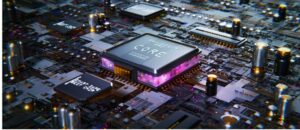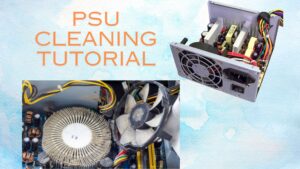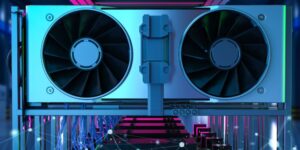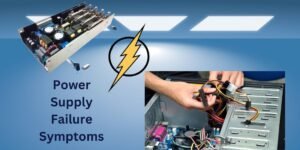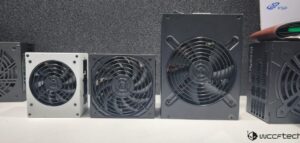Which Way Should PSU Fan Face?
When building or upgrading a PC, most people focus on selecting powerful components like the CPU, GPU, and motherboard, often overlooking the small but important decisions that affect system performance and longevity. One such detail is the orientation of the power supply unit (PSU) fan. While it might seem insignificant, the direction your PSU fan faces can influence your system’s cooling efficiency, dust management, and overall airflow balance. Most modern PC cases position the PSU at the bottom, leaving builders with a choice: should the fan face upward into the case or downward toward the floor? The right answer depends on several factors, including your case design, airflow configuration, surface placement, and maintenance routine. In this article, we’ll explore the pros and cons of each orientation, explain how airflow mechanics work, and help you determine the best PSU fan direction for your specific setup, ensuring your system runs cool, clean, and efficiently.
Understanding How a PSU Fan Works:
A power supply unit (PSU) is the heart of your PC’s electrical system, converting AC power from your wall outlet into stable DC voltages for your components. Inside the PSU, a fan is used to draw in air to cool the internal components like transformers, capacitors, and voltage regulators, preventing them from overheating. Most modern PSUs use a 120mm or 140mm intake fan (often located at the bottom of the unit) to pull in cool air, pass it over the internal components, and expel the warmed air out the rear of the case through a ventilation grille.
The key takeaway:
- The PSU fan is an intake fan that pulls air into the PSU.
- The expelled warm air exits out the back of your case, separate from the CPU and GPU exhaust pathways.
This means the orientation of the PSU’s fan affects where it draws its air from — either from inside your case or from underneath it (through a filtered vent if your case supports it).
Case Design and PSU Placement Options:
Modern PC cases predominantly use a bottom-mounted PSU design. Older cases placed the PSU at the top, but bottom-mounted designs have become standard due to improved weight distribution, lower centre of gravity, and superior thermal management.
1: Bottom-Mounted PSU Cases
Most mid-tower and full-tower cases have a dedicated PSU shroud or compartment at the bottom, with a perforated, filtered vent below the PSU’s position. Builders can choose whether to mount the PSU fan facing downward toward this vent or upward into the case.
2: Top-Mounted PSU Cases
Less common today, these cases position the PSU at the top of the chassis. In this scenario, the PSU fan usually faces downward into the case by necessity.
The correct PSU fan orientation depends on:
- The presence and quality of venting below the PSU
- Whether a dust filter is installed
- The overall case airflow design
- Environmental conditions like dust levels and airflow clearance
PSU Fan Facing Down: Advantages and Disadvantages
When the fan faces downward:
The PSU draws in cool air directly from outside the case through a vent on the bottom panel and exhausts warm air out the rear.
Advantages:
- Cooler air intake: Pulls in ambient room air (usually cooler than the air inside your case), reducing PSU temperatures.
- Isolated airflow path: Keeps PSU airflow separate from CPU and GPU thermal zones, improving overall case cooling efficiency.
- Dust management: Most cases provide a removable dust filter for the bottom vent, simplifying cleaning and minimizing internal dust accumulation.
Disadvantages:
- Requires adequate clearance: There must be enough space (typically at least ½ inch or 12mm) between the case bottom and the surface it’s placed on to ensure airflow.
- More dust from floor surfaces: If your PC sits on carpet or in a dusty environment, the PSU can draw in more debris.
- Filter maintenance: The bottom filter requires regular cleaning to prevent airflow obstruction.
Best for:
- Cases with a filtered bottom PSU vent
- Systems requiring optimal thermal separation
- PCs placed on hard, dust-free surfaces
PSU Fan Facing Up: Advantages and Disadvantages
When the fan faces upward:
The PSU draws warm air from inside the case and exhausts it out the rear.
Advantages:
- Improved airflow on carpeted or enclosed surfaces: If your PC sits on a thick carpet or in a tightly enclosed shelf, facing the fan up ensures unobstructed airflow.
- Potential extra exhaust for GPU area: In cramped cases with poor GPU exhaust pathways, this setup can assist in removing hot air rising from graphics cards.
Disadvantages:
- Hotter intake air: The PSU draws in air warmed by CPU, GPU, and motherboard, leading to higher PSU temperatures.
- Interferes with case airflow: Competes with other components for airflow, potentially disrupting optimal thermal patterns.
- More internal dust: Pulls dust from within the case into the PSU, increasing cleaning requirements.
Best for:
- Cases without a bottom vent
- PCs placed on carpet or soft surfaces
- Compact cases with restricted airflow configurations
Factors to Consider When Deciding PSU Fan Orientation
Before you decide which way your PSU fan should face, it’s important to assess a few key factors that influence airflow, cooling performance, and long-term system health. The right orientation isn’t always the same for every build, it depends on your case design, environment, and usage habits. Here’s what you should carefully consider:
1. Case Design and Ventilation
Check if your case has a vent with a dust filter beneath the PSU mounting area. If so, a fan-down setup is typically ideal, as it allows the PSU to pull in fresh, cool air from outside the case. If your case lacks a bottom vent, you’ll need to face the fan upward to ensure it can draw in air freely.
2. Surface Placement
The surface your PC rests on affects airflow. Hard surfaces like wood, tile, or metal desks are suitable for downward-facing fans, especially if your case has elevated feet. However, if your PC sits directly on carpet, a thick rug, or an enclosed shelf, the bottom vent can get blocked, restricting airflow. In these cases, it’s safer to face the fan upward to prevent overheating.
3. Clearance Beneath the Case
Even with a bottom vent, your case must have adequate clearance between the floor and the vent opening. Most manufacturers recommend at least 12mm (½ inch) of space for proper airflow. Check the height of your case’s feet or standoffs to be sure, insufficient clearance can suffocate a fan-down PSU setup.
4. Airflow Configuration of the Entire System
Consider how air moves through your PC case overall. High-performance gaming builds with powerful GPUs and CPUs benefit from isolating the PSU’s airflow path by having it pull cool air from outside (fan down). In contrast, compact or budget cases with limited airflow options might function better with the fan facing up, where it can assist in exhausting warm air from the case.
5. Dust Management
Dust buildup can hinder cooling performance and shorten component lifespan. A fan-down PSU setup with a bottom dust filter is easier to maintain and keeps dust from entering the PSU’s internal components. However, if you rarely clean your filters or live in a particularly dusty environment, an upward-facing fan might collect less floor dust, though it will still draw in dust from inside your case.
6. System Power and Heat Output
High-wattage PSUs and gaming rigs that generate significant heat benefit from cooler, isolated intake air. In these systems, a downward-facing fan setup is preferred, as it helps maintain lower PSU temperatures. Lower-power office PCs or secondary systems can often run fine with either orientation, provided airflow isn’t blocked.
Special Scenarios: Open-Air Benches and Custom Enclosures
While most PC builds follow standard case designs, some setups use unique configurations like open-air test benches or custom enclosures. These special scenarios require a slightly different approach when deciding the PSU fan orientation. Let’s break down what you should consider in these cases.
1. Open-Air Test Benches
Open-air test benches are popular among enthusiasts, reviewers, and overclockers because they provide unrestricted access to components and excellent natural airflow. In this setup, airflow isn’t confined by a traditional case, so PSU fan orientation is generally less critical.
- Recommendation: Face the PSU fan in a direction where it won’t easily collect dust or get blocked by nearby objects. Since there’s no enclosure to trap heat, the PSU can operate effectively in either direction as long as the intake side remains unobstructed.
2. Custom Enclosures
Custom-built or modified PC enclosures often have unconventional layouts, sometimes placing the PSU in unique positions like sideways, vertically, or within a dedicated chamber. In these setups, it’s important to carefully evaluate how airflow works within the custom design.
- If the enclosure has a vented bottom panel with clearance: Install the PSU with the fan facing down to pull in cooler air from outside.
- If the enclosure lacks a bottom vent or places the PSU against a solid surface: Mount the PSU with the fan facing into the enclosure to ensure it has access to an open air source.
3. Wall-Mounted and Desk-Integrated Builds
Some builders opt for wall-mounted PCs or custom desks with built-in hardware compartments. These setups can sometimes limit airflow depending on the layout and available venting.
- Recommendation: Always position the PSU fan toward the side with the most ventilation or airflow clearance. If placing it face down would obstruct airflow or press the fan against a surface, it’s better to orient it upward or sideways, depending on the case’s airflow path.
Dust Management and Maintenance:
No matter how powerful or well-designed your PC build is, dust is an unavoidable challenge. It can clog fans, block vents, and reduce cooling efficiency over time, and your power supply unit (PSU) is no exception. Whether your PSU fan faces up or down, keeping dust under control is crucial for maintaining stable temperatures, system performance, and component lifespan.
Why Dust Management Matters?
As your PSU pulls in air to cool its internal components, it can also draw in fine dust particles. Over time, this dust builds up inside the PSU, restricting airflow and forcing the fan to work harder. This leads to increased temperatures, more noise, and can even shorten the PSU’s lifespan.
Additionally, dust buildup inside the PSU is difficult to clean without disassembling it — which is risky and not recommended for most users. That’s why preventing dust from getting inside in the first place is essential.
Best Practices for Managing Dust:
1. Use Dust Filters
Most modern PC cases come equipped with removable dust filters on the bottom vent where the PSU typically sits. These filters trap dust before it can enter the PSU. If your case doesn’t have one, consider adding a third-party magnetic or adhesive dust filter.
2. Clean Filters Regularly
A dust filter won’t help if it’s clogged. Check and clean the filter every 2 to 4 weeks, depending on how dusty your environment is. Simply remove the filter and gently vacuum or rinse it, allowing it to dry fully before reinstalling.
3. Keep the PC Off the Floor
Placing your PC directly on the floor — especially on carpet — increases the amount of dust entering your system. If possible, position your PC on a desk, stand, or elevated surface to reduce exposure to floor-level dust.
4. Periodic Internal Cleaning
Even with good filtration, some dust may still enter your case. Periodically use a can of compressed air to blow dust out of case fans, vents, and visible PSU grills. Avoid inserting anything into the PSU itself.
5. Monitor PSU Temperature and Noise
If your PSU fan starts running louder than usual or if you notice higher internal temperatures, it might be a sign of restricted airflow due to dust buildup. Address this quickly by checking and cleaning your filters and vents.
Conclusion
Choosing the correct orientation for your PSU fan is a crucial but often overlooked aspect of building a reliable and efficient PC. While it may seem like a minor decision, it directly impacts your system’s airflow, cooling efficiency, and dust management. In most situations, facing the PSU fan downward is ideal if your case has a bottom vent with a dust filter, as it allows the PSU to draw in cooler air from outside the case while keeping internal airflow pathways isolated. However, if your case lacks a bottom vent or sits on a carpeted or enclosed surface, positioning the fan upward becomes the safer and more practical choice. Ultimately, the best orientation depends on your case design, environmental conditions, and maintenance habits. By paying attention to these details and ensuring adequate airflow clearance, you can prolong your PSU’s lifespan, maintain stable temperatures, and enhance the overall health of your PC build.
FAQs
1. Can I change the PSU fan orientation after installation?
Yes, you can change the PSU fan orientation, but it might require removing and reinstalling the unit, depending on your case’s design.
2. What happens if my PSU overheats?
An overheating PSU can lead to system instability and, in extreme cases, hardware damage. It’s essential to ensure proper cooling to prevent this.
3. Are there any PSU models that don’t have fans?
Yes, some PSU models are fanless, relying on passive cooling. These are typically designed for low-power systems or those that require silent operation.
4. Should I use additional case fans with my PSU?
Additional case fans can help improve overall airflow, benefiting both your PSU and other components. However, their effectiveness depends on your case’s design and layout.
5. Can I use liquid cooling for my PSU?
Liquid cooling for PSUs is rare and usually unnecessary. It’s more common and practical to focus on cooling other components, such as the CPU and GPU.
Last Updated on 20 May 2025 by Ansa Imran

Ansa Imran, a writer, excels in creating insightful content about technology and gaming. Her articles, known for their clarity and depth, help demystify complex tech topics for a broad audience. Ansa’s work showcases her passion for the latest tech trends and her ability to engage readers with informative, well-researched pieces.


